Roland Boutique SE-02 Review – An Unexpected Surprise
Roland’s new Boutique is an analogue synth with input from Studio Electronics. Dave Gale takes a look at this coming together of two great companies…
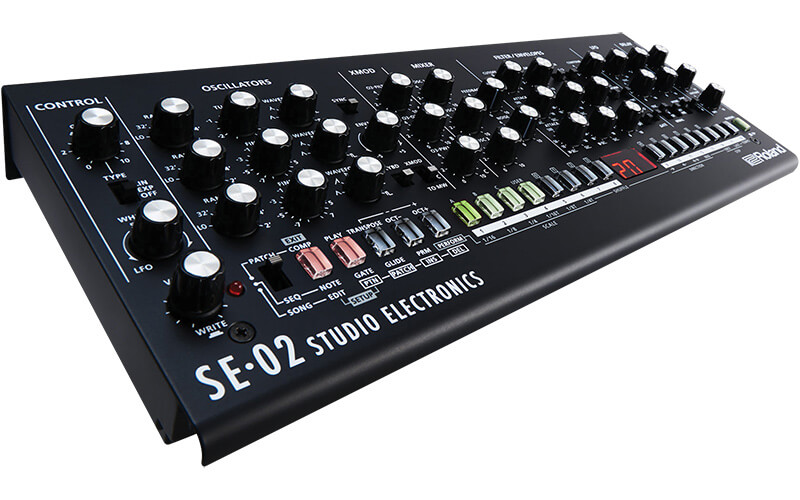

Price £509
Contact Roland
Web www.roland.co.uk, 01792 702701
![]()
SE-02 key features
- Monophonic analogue synthesiser
- Authentic discrete circuit design
- Knob-per-function interface
- Lots of modulation possibilites
- MIDI, USB and CV connectivity
- Audio over USB
- 128 user-memory locations/384 presets
- Onboard sequencer
Okay, hands up… Who saw this one coming? Well, none of us, really, but it is very much something we‘ve wanted to see from Roland for some time. The company’s established Boutique range has been pretty much based around the reimagining of some of its old classics, and in all cases using its (very good) Analog Circuit Behaviour technology (ACB), which is very firmly a digital affair.
So, when the SE-02 was announced, it caught everyone out on two fronts; firstly, it was an analogue synth with no hint of ACB, but also had a voice architecture that wasn’t reminiscent of other Rolands – it was a slightly different flavour, with more of a leaning towards the East Coast of the USA.
The other point that makes the SE-02 different and unique is that it’s the first of Roland’s ‘Boutique Designer Series’. You can’t really miss the Studio Electronics name, which is emblazoned along the bottom of the module, and even the product name SE-02 harks back to the Studio Electronics SE-1 and SE-1X, both of which are cult classics from the Studio Electronics stable.
Studio Electronics is a Californian company with an impeccable reputation for excellent synthesisers, especially with its current range, which occupies the standalone, rackmounted and Eurorack camps. I have long thought its modules are some of the best in the marketplace in terms of sound, design and build quality, so the moment I heard about the SE-02, I had a pretty good idea of what might await.
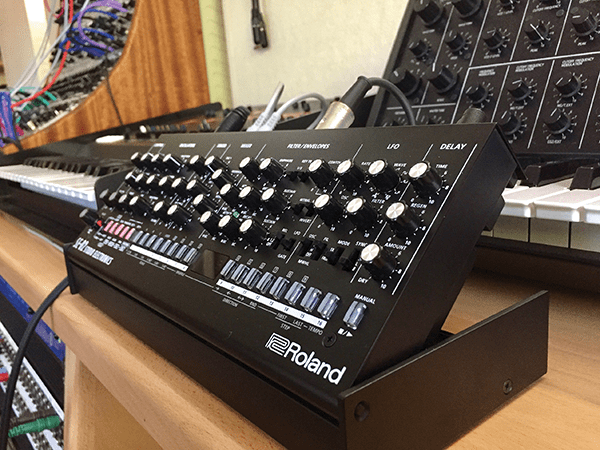
Unboxing the SE-02, there are no surprises. It’s the usual Roland Boutique form, but with this particular model, there is a lack of the Boutique dock which is included with certain other models, such as the TB-03 and TR-09. This omission may be because it’s quite likely you’ll want to add one of Roland’s K-25m keyboards instead, to give that immediacy that you would get with any monosynth. However, it is the usual Boutique size, so you can always add a DK-01 Boutique Dock, which will offer you a ‘play it flat’ or ‘play it tilted’ experience. For our purposes, our review model is a pre-production version, sitting in a regular dock.
Power will need to be supplied via the included DC power supply, with no option for running from batteries – presumably down to the power consumption of the analogue circuitry within. There is, however, a little speaker built in, which is functional, but obviously lacks the frequency response you’ll want. Trust me when I say that you’ll not want to ‘go there’ for your first outing with the SE-02, as I discovered very quickly.
Get it on
Powering up and plugging in, and my first temptation was to hit the Sequencer button. Putting the actual collection of notes to one side, the sound is just amazing. It’s the depth that hits you first; heavy hitting in the lower mids, with plenty of clarity in the top end, and even though I had literally just switched it on, it was in tune, although I would fully expect there to be little warm-up period, as there would be with any analogue.
The main fascia is literally littered with rotary pots and switches, with the lower quarter of the main panel given over to illuminated buttons and a central red LED display, which is the go-to area for patch recall and sequencer duties. It has to be said, it doesn’t feel too cluttered, but the pots are quite small and there is a lot packed into the relatively small fascia space.
Doubtless, many will rhetorically ask why Roland couldn’t have moved away from the Boutique form factor in favour of making the panel a little larger, but there’s the added advantage that everything is under MIDI CC control, so it’s possible to hook up to your favoured MIDI controller and tweak the SE-02 that way instead. Sensibly, the rotary pots have far more control than the short-throw faders seen on other Boutiques, so it’s not difficult to control, just a little small.
Do I really need this?
If you’re looking for an analogue synth at a sensible price but in a small form factor, this should be one to look at. It’s great sounding and has some serious credentials right where you want them, starting with three oscillators and will be a great fit for many people.
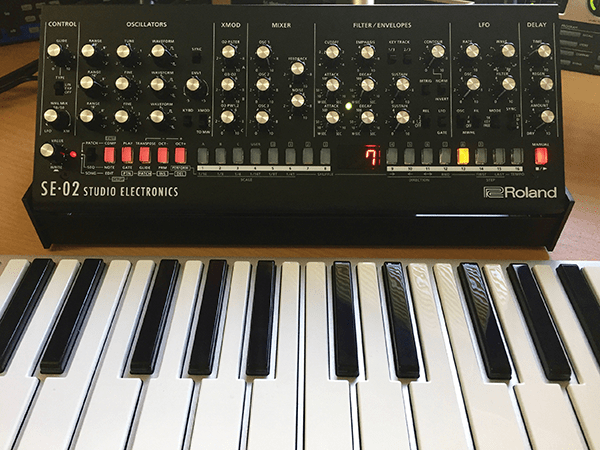
It’s not cheap, at £509, but this should be an assured sign of the quality. It’s an all-analogue design, in a metal case… and despite the small form, is well made.
Triple whammy
The SE-02 is very much a collaborative design, and the influence of SE is clear. Roland has always liked the idea of single- and/or dual-oscillator designs, often with a suboscillator; but right at the beginning of the signal flow, the SE-02 offers three oscillators, with separate white noise.
This makes it far more reminiscent of a Minimoog-like design, which, it’s certainly fair to say, would probably be down to SE and its traditions, and with further nods to the East Coast classic, each oscillator offers an Oscillator Range pot (including LFO mode), Fine Tune pot and the choice of six waveforms on each. Oscillator One and Two offer Triangle, Saw, three gradients of Pulse in varying widths, and the legendary ‘Sharktooth’ wave, which is a mixture of Saw and Triangle.
Regrettably, these waves are not sweepable, with a fixed switch between each. The Sharktooth is missing from Oscillator Three, in favour of a reversed Saw ramp, allowing for modulation use elsewhere. Oscillator Two is sync’able with Osc One – and to further add to this, Osc Two deploys a pot to assign one of the envelopes to pitch control, for those wondrous sweeping sync tones.
Sonically, the oscillators sound rich in all areas. Even with a single oscillator in play, there’s a very beautiful depth to the sound which is fruity but tight. There’s no flab here, just plenty of pure tonal source to get cracking with, and there’s a lovely high-end fizz, when no filtering is in play. Frankly, I’d buy this for the oscillators alone!
The oscillators are all blended together, à la Moog, within the dedicated mixer section, which offers five pots; three relating to the oscillators, one for white noise and a feedback amount. In another nod to our East Coast cousins, the ‘feedback’ amount loops the output (pre FX) back into the filter. This results in fairly swift howling, reminiscent of the old ‘headphone to external input’ trick, which might be heard on a Minimoog.

To my ears, it’s sonically a little different from a Moog, with more high-end squeal and less low-end grunt, which may well be down to the filter design. The VCF is a fixed 24dB/octave low-pass design, which definitely has more of a Roland feel and sonic fingerprint, which makes for an interesting pairing with the three oscillators upfront. With full resonance applied, there’s plenty of that Roland ‘whistle’, but when it’s backed off a bit, we get that beautiful wispiness in the top end that’s very pleasing indeed.
While we’re in the domain of the filter, there are tracking options for keyboard control of the cutoff, through two switches. These can be switched off, or applied at 33.3%, 66.6% or the full 100%. I found this to be very reliable over several octaves, opening possibilities for playing the filter, in that way we love to do with old SH models.
In the same section, two ADS envelopes are to be found, the first being assigned to filter duties and the second to amplitude. There is a Release switch here, which will introduce the ability to control the release phase through the Decay pot. This can be defeated on both envelopes, or applied to Envelope Two, or both envelopes, which covers most eventualities.
The filter envelope can also be assigned to other duties, most notably the pitch of Oscillator Two, and in my experimentations, I have to say that despite the small fascia, things are laid out pretty logically, with the ability to achieve most things tyou should want to do. It’s almost like there was a starting point in mind, and as discussions progressed, various useful things have been added along the way, in that wonderful way that a collaboration of this kind can bring forth great ideas.
The new mods
For many of us who’ve been teased by the run of demonstration videos that Roland has drip-fed us, its cross-modulation options have been particularly exciting – we’re spoilt for choice, with three types. X-Mod One allows a path from Oscillator Two, to the filter cutoff, while X-Mod Two allows Oscillator Three to modulate the waveform of Oscillator Two. In both of these cases, some wonderful audio range modulations occur, to give tremendous gnarly colour.
Put the two together with a healthy dose of filter resonance and feedback, and you have the ability to create some stunning audio effects, which remind me of the sort of things that are achievable on machines like the Jupiter-8. Not to be outdone, the third X-Mod element relates to Pulse Width Modulation of the Square/Pulse wave on Oscillators One and Two, with the source being taken from Oscillator Three.
You might naturally be drawn to place Oscillator Three in ‘Lo’ mode at this point and for me, I found the rate of oscillation just too quick: I failed to get the really slow rate that I often like, to generate slow PWM movement. Curiously, the LFO section is a very separate affair and offers a vast number of control possibilities, but it’s not possible to use the LFO to control PWM, which would be the obvious solution to my speed-of-modulation issue.
Not to get hung up on this point, what the LFO does offer is nonetheless substantial; there are nine LFO wave options, which include Saw Ramps in both directions and Random CV generation, along with a Rate pot and Amount pots to send the LFO to oscillator frequency (pitch) and filter cutoff. But where the LFO stands out from some other synths is with the four switches, which allow for control, routing and sync’ing.
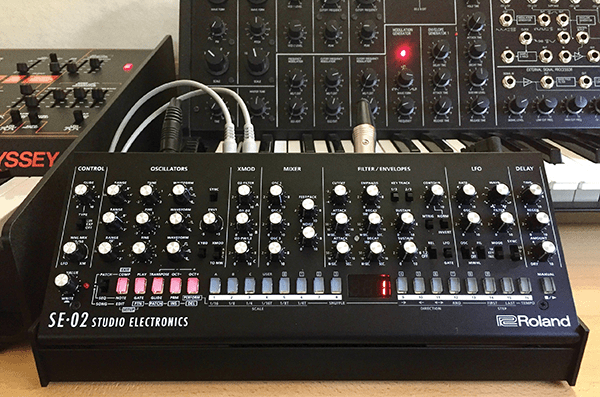
Two of these relate to use with a mod wheel, immediately demonstrating the performance credentials of the SE-02, while the other two switches relate to mode of operation and sync’ing. The Mode switch will allow the user to set to the usual free flowing, or use a one-cycle mode, or key-start mode. It’s unusual to see this level of control on a synth like this and so obtainable from the front fascia. Similarly, the Sync switch will allow easy locking of the LFO and delay effect to the MIDI clock, or leave it in freewheeling mode.
Looking at both the front and back ends of the signal chain, the front offers a Glide Amount control, with further application of the glide type, offered in either Exponential or Linear. The back end of the signal flow offers a single effect, in the shape of a delay. It’s basic but effective, with Delay Time and Regeneration controls, along with a Wet/Dry mix control.
Turning our attention to the patching, we have plenty to work with. There are 384 presets, which cannot be overwritten.
I’d question the need for so many, as with a synth like this, you’ll be wanting to get creative and make your own sounds…but fear not, because there is a User bank, offering 128 locations to store your own timbres. In the same department, there’s an in-built sequencer which conforms to the old-style drum-machine architecture of patterns being linked together to create up to 16 different songs. It’s also possible to write control-panel movements into the pattern, meaning that all those tweaks can be recalled, along with the pattern and the patch timbre.
The rear panel also gives us some useful options. Apart from MIDI In and Out, available through five-pin sockets and USB, there is a CV/Gate input, and a CV input for control of the filter cutoff. There is also a trigger input and output, should you want to hook this into other like-minded devices, and register a Start or Stop to a sequence. Audio output is available on a stereo mini-jack connector, along with a mini-jack headphone output. Helpfully, there is also an audio input, which will feed an external source directly to the filter and delay.
Roland SE-02 overview
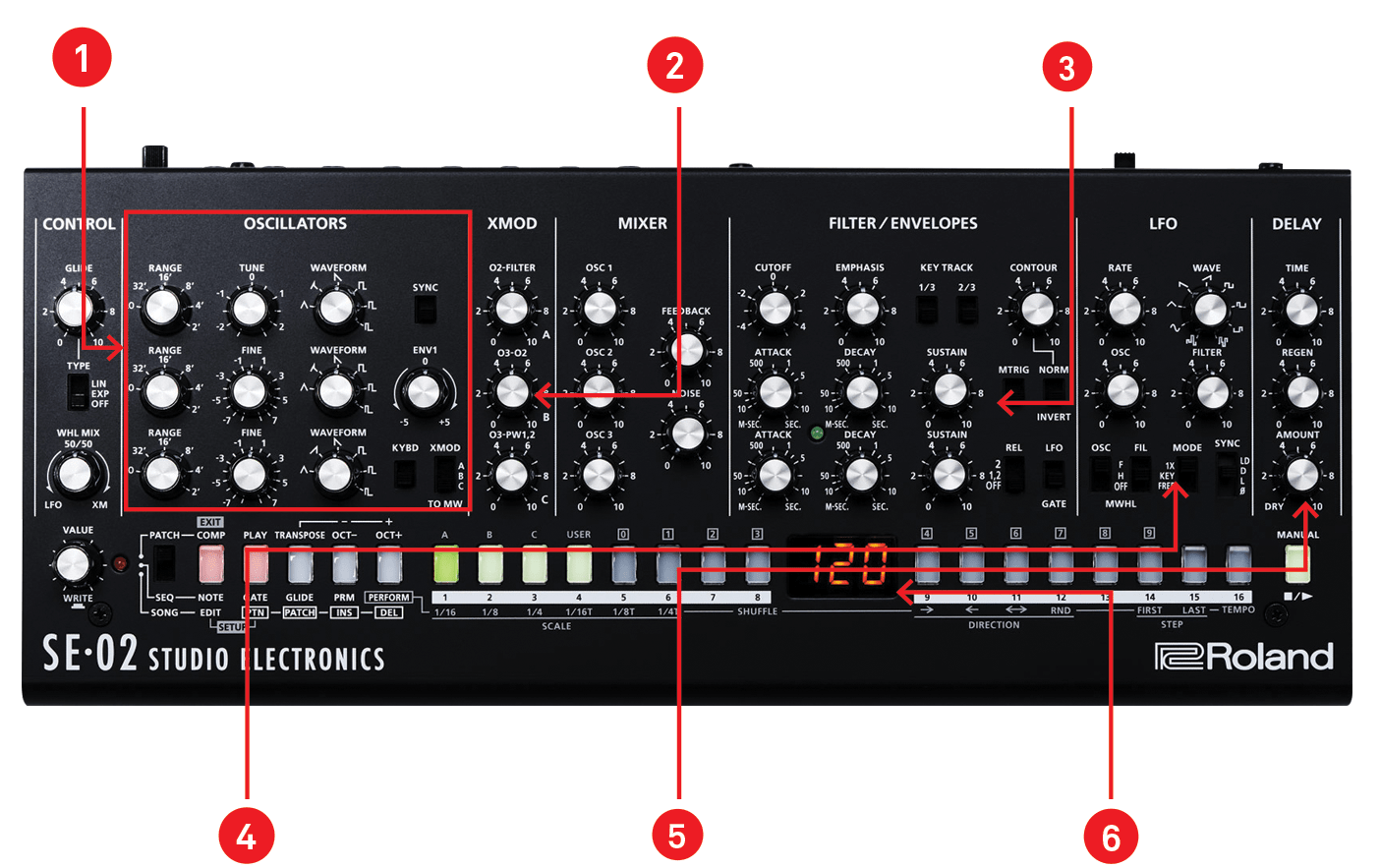
1. Oscillator section – In a switch from the Roland norm, three full oscillators offer a Moog style front-end, with plenty of timbral choice, including the infamous ‘sharktooth’ waveform.
2. X-Mod Section – Not one, not two, but three tasty flavours of cross modulation, placed right at the heart of the signal flow, for aggressive tones and far more.
3. Filter/Envelopes Section – More Mini-like qualities with the styling of the two envelopes, nestling right next to the filter controls. The cutoff has various options for tracking across the range.
4. LFO Section – A dedicated LFO won’t leave you an Oscillator down at the front end. Spoilt for waveform choice, everything from Sines to randomness is available.
5. Delay Section – It’s always great to have the convenience of an inbuilt delay and this proves very useful, particularly when hooked in with the onboard sequencer.
6. Patch/Sequencer Section – The multi-functional buttons across the bottom allow for quick patch recall and step-location sequencing.
The final performance
One point Roland is very keen to hammer home is that although the Boutique has a small form factor, this should not diminish its potential as a studio machine or a performance synth. All of the elements you might want to control are fully accessible via MIDI CCs and it would be very easy to play the Boutique from a larger controller-type keyboard and tweak as you go.
This was something I tried very successfully and in a matter of seconds, with a Nektar Panorama – and I can report that the SE-02 is very responsive in this scenario. There is always the rhetorical: “Why not just make it in a keyboard form?”, which would be the preference for many, but then you would lose the small footprint and ability to have it sat on the desk, right next to you. It’s got that wonderful kudos of a performance interface that wants you to grab hold of controls and tweak them on the fly, and in this regard, I really like it.
In fact, I like the SE-02 in all regards. It sounds very good indeed and is a very creative subtractive synth with an awful lot going for it. I’m very well versed with the sound of both Roland machines and the current SE range of Eurorack modules, which I believe are some of the best (and best made!) modules on the market today, and the SE-02 really brings us the best of both camps.
What I especially like is the starting point of the voice architecture, which is not the norm for Roland; it offers such a wealth of creative possibilities – and I’m just talking about the oscillators here. Add in the rest: the superbly precise filter, the cross-modulation and a pair of envelopes, and you’re onto a winner.
There’s a lovely sonorous depth to the SE-02’s sound, which will just sit beautifully in a mix, but it also has the capacity to shriek in various ways. The filter sounds terrific; add in the levels of distortion available through the Feedback control and X-Mod, and you’ve got yourself a very flexible device, which is full of wondrous sonic capabilities… so much so, in fact, you’ll probably just want to get your hands dirty and create great sounds.
Don’t forget, this is a fully formed analogue synth – it’s just that it happens to reside in a Boutique case, the latter point possibly being the only stumbling block for some, in which case, you’ll just have to bite the bullet and buy a bigger keyboard – because once you’ve heard the sound, I suspect you’ll want one.
Alternatives
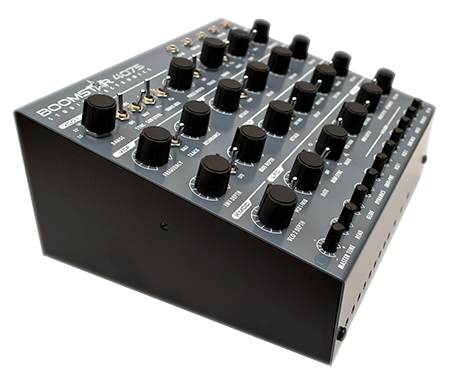
Studio Electronics
Boomstar £769
Think ‘SE-02 on steroids’ with a choice of filter types, but you’ll be paying around £769.
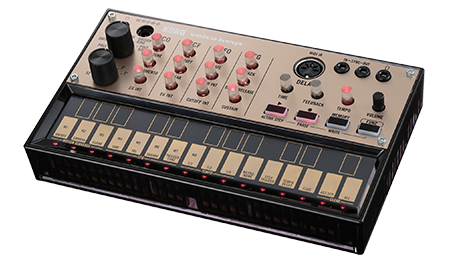
Korg
volca £129
If your budget is really tight, this series is very hard to beat! Full of fun and quirkiness, there are several to try.
